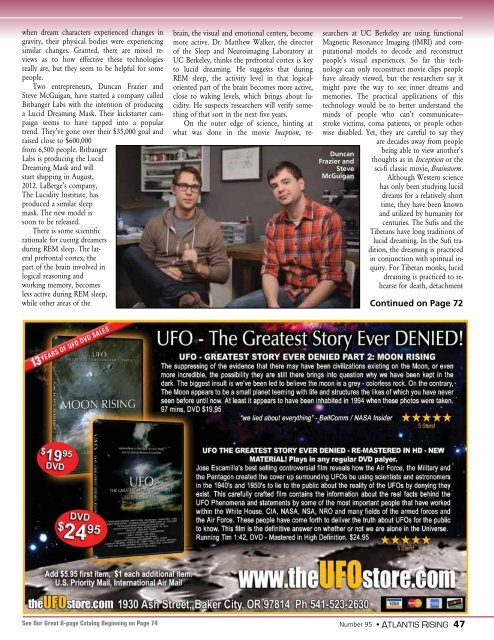Do We Know What We Think We Know About ... - TheUFOStore.com
Do We Know What We Think We Know About ... - TheUFOStore.com
Do We Know What We Think We Know About ... - TheUFOStore.com
Create successful ePaper yourself
Turn your PDF publications into a flip-book with our unique Google optimized e-Paper software.
when dream characters experienced changes in<br />
gravity, their physical bodies were experiencing<br />
similar changes. Granted, there are mixed reviews<br />
as to how effective these technologies<br />
really are, but they seem to be helpful for some<br />
people.<br />
Two entrepreneurs, Duncan Frazier and<br />
Steve McGuigan, have started a <strong>com</strong>pany called<br />
Bitbanger Labs with the intention of producing<br />
a Lucid Dreaming Mask. Their kickstarter campaign<br />
seems to have tapped into a popular<br />
trend. They’ve gone over their $35,000 goal and<br />
raised close to $600,000<br />
from 6,500 people. Bitbanger<br />
Labs is producing the Lucid<br />
Dreaming Mask and will<br />
start shipping in August,<br />
2012. LaBerge’s <strong>com</strong>pany,<br />
The Lucidity Institute, has<br />
produced a similar sleep<br />
mask. The new model is<br />
soon to be released.<br />
There is some scientific<br />
rationale for cueing dreamers<br />
during REM sleep. The lateral<br />
prefrontal cortex, the<br />
part of the brain involved in<br />
logical reasoning and<br />
working memory, be<strong>com</strong>es<br />
less active during REM sleep,<br />
while other areas of the<br />
See Our Great 8-page Catalog Beginning on Page 74<br />
brain, the visual and emotional centers, be<strong>com</strong>e<br />
more active. Dr. Matthew Walker, the director<br />
of the Sleep and Neuroimaging Laboratory at<br />
UC Berkeley, thinks the prefrontal cortex is key<br />
to lucid dreaming. He suggests that during<br />
REM sleep, the activity level in that logicaloriented<br />
part of the brain be<strong>com</strong>es more active,<br />
close to waking levels, which brings about lucidity.<br />
He suspects researchers will verify something<br />
of that sort in the next five years.<br />
On the outer edge of science, hinting at<br />
what was done in the movie Inception, re-<br />
searchers at UC Berkeley are using functional<br />
Magnetic Resonance Imaging (fMRI) and <strong>com</strong>putational<br />
models to decode and reconstruct<br />
people’s visual experiences. So far this technology<br />
can only reconstruct movie clips people<br />
have already viewed, but the researchers say it<br />
might pave the way to see inner dreams and<br />
memories. The practical applications of this<br />
technology would be to better understand the<br />
minds of people who can’t <strong>com</strong>municate—<br />
stroke victims, <strong>com</strong>a patients, or people otherwise<br />
disabled. Yet, they are careful to say they<br />
are decades away from people<br />
Duncan<br />
Frazier and<br />
Steve<br />
McGuigan<br />
being able to view another’s<br />
thoughts as in Inception or the<br />
sci-fi classic movie, Brainstorm.<br />
Although <strong>We</strong>stern science<br />
has only been studying lucid<br />
dreams for a relatively short<br />
time, they have been known<br />
and utilized by humanity for<br />
centuries. The Sufis and the<br />
Tibetans have long traditions of<br />
lucid dreaming. In the Sufi tradition,<br />
the dreaming is practiced<br />
in conjunction with spiritual inquiry.<br />
For Tibetan monks, lucid<br />
dreaming is practiced to rehearse<br />
for death, detachment<br />
Continued on Page 72<br />
Number 95 • ATLANTIS RISING 47


